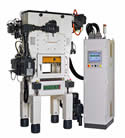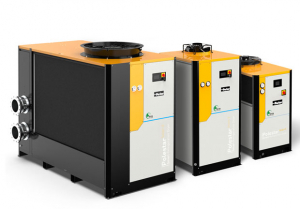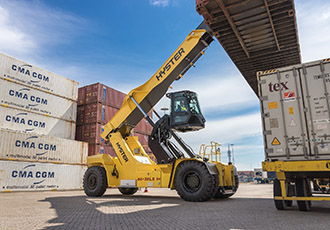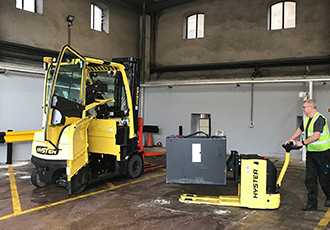High-speed press for manufacturing small, complex components
13th May 2008
Source:
The Right Image

Stamping small items like electronic components, watch parts and automotive connectors does not require high tonnage. However, to mass produce today’s ever more complex products, progression tools with increasing numbers of stages are needed, which in turn require a long bed to accommodate them. The new Bruderer BSTA 200 high-speed press is aimed precisely at this market.
Until now, a manufacturer would have had to buy an unnecessarily large, powerful stamping press to get a bed of sufficient length to suit some multi-stage tools which, despite shorter feed pitches, are becoming ever longer. The new press model from Bruderer combines 20 tonnes (200 kN) punching force, at the low end of the Swiss manufacturer’s range, with a generous bolster plate area of either 590 mm or 690 mm by 426 mm for loading the tools.
The economically priced press, which also has new control and feed systems, has been introduced to reduce manufacturing costs and help the West to compete with the threat from Asia and Eastern Europe.
The standard machine has a fixed 15 mm stroke, while greater versatility of operation is available if the user chooses one of two options, either two fixed strokes (8 mm / 25 mm) or adjustable stroke in seven increments from 8 to 38 mm. Ram adjustment over 40 mm can be carried out while stamping is in progress to fine-tune the position of bottom dead centre. Stroke rate is up to 2,000 per minute.
As with all Bruderer presses, the rigid drive shaft is mounted transversely, transmitting its power to the ram via two con rods and a lever system with mass counterbalancing for stability at high speeds. Absence of any lateral forces means that it has been possible to place the ram guides at strip level, avoiding punch deflection due to eccentric loads in the die.
An innovation with this latest press is the mechanical drive from the main shaft to the rollers feeding the strip through the tool. Instead of a single, angled linkage, a right-angle arrangement is used that allows the cardan shaft to enter the mechanical feed unit vertically. The advantage is that changeover of the feed from one side of the press to the other is much faster, as the unit does not have to be dismantled.
Speed of set-up is assisted further by placing the encoders in the top mount instead of on the side of the feeder. It has the additional benefit of protecting the encoders from vibration and making them more accessible for servicing.
The standard mechanical roller feed unit for the BSTA 200 is the new BBV180, which features quick-change rollers and automatic strip thickness adjustment. Material up to 200 mm wide may be fed and pitches up to 100 mm are possible. A gripper feed unit may be used instead if the application dictates.
Available also is the Bruderer BSV range of servo feeds, of which two sizes are applicable to the 200 kN press – BSV75/75T and BSV170 – the number representing maximum strip width. The former models may be used for tandem feeding of two strips through the tool simultaneously, or for wide material. Maximum strip thickness is 2 mm.
The servo feed unit is synchronised with the angle of the main drive shaft and interfaced with the control. It can be used to push or pull the strip through the tool. Both the upper and lower rollers are driven so that pressure is transmitted equally.
The result is that during punching, the rollers are able to clamp the strip without the need for clamping bars, avoiding the risk of marking the material. Lubrication and cooling is integrated with that of the press, minimising maintenance. (All BSV servo feeds, including the new, larger BSV300, can be retrofitted any model of Bruderer presses.)
High-speed stamping and forming including deep drawing, as well as any additional processes that may follow, such as assembly or over-moulding, all require high accuracy and repeatability. This is ensured by Bruderer’s new, PC-based, touch-screen ‘BE’ control system, introduced for the latest 20 tonne presses.
Functions provided include memory of tool / die parameters to allow rapid set-up for repeat batches, stepless speed adjustment, servomotor controlled ram adjustment with integrated position encoder, and manual feed length adjustment with digital display of values. Among the many options are press force measurement, tool monitoring and 100 per cent, real-time inspection of stamped components. Coil handling and other ancillary options are also available through Bruderer UK.
The economically priced press, which also has new control and feed systems, has been introduced to reduce manufacturing costs and help the West to compete with the threat from Asia and Eastern Europe.
The standard machine has a fixed 15 mm stroke, while greater versatility of operation is available if the user chooses one of two options, either two fixed strokes (8 mm / 25 mm) or adjustable stroke in seven increments from 8 to 38 mm. Ram adjustment over 40 mm can be carried out while stamping is in progress to fine-tune the position of bottom dead centre. Stroke rate is up to 2,000 per minute.
As with all Bruderer presses, the rigid drive shaft is mounted transversely, transmitting its power to the ram via two con rods and a lever system with mass counterbalancing for stability at high speeds. Absence of any lateral forces means that it has been possible to place the ram guides at strip level, avoiding punch deflection due to eccentric loads in the die.
An innovation with this latest press is the mechanical drive from the main shaft to the rollers feeding the strip through the tool. Instead of a single, angled linkage, a right-angle arrangement is used that allows the cardan shaft to enter the mechanical feed unit vertically. The advantage is that changeover of the feed from one side of the press to the other is much faster, as the unit does not have to be dismantled.
Speed of set-up is assisted further by placing the encoders in the top mount instead of on the side of the feeder. It has the additional benefit of protecting the encoders from vibration and making them more accessible for servicing.
The standard mechanical roller feed unit for the BSTA 200 is the new BBV180, which features quick-change rollers and automatic strip thickness adjustment. Material up to 200 mm wide may be fed and pitches up to 100 mm are possible. A gripper feed unit may be used instead if the application dictates.
Available also is the Bruderer BSV range of servo feeds, of which two sizes are applicable to the 200 kN press – BSV75/75T and BSV170 – the number representing maximum strip width. The former models may be used for tandem feeding of two strips through the tool simultaneously, or for wide material. Maximum strip thickness is 2 mm.
The servo feed unit is synchronised with the angle of the main drive shaft and interfaced with the control. It can be used to push or pull the strip through the tool. Both the upper and lower rollers are driven so that pressure is transmitted equally.
The result is that during punching, the rollers are able to clamp the strip without the need for clamping bars, avoiding the risk of marking the material. Lubrication and cooling is integrated with that of the press, minimising maintenance. (All BSV servo feeds, including the new, larger BSV300, can be retrofitted any model of Bruderer presses.)
High-speed stamping and forming including deep drawing, as well as any additional processes that may follow, such as assembly or over-moulding, all require high accuracy and repeatability. This is ensured by Bruderer’s new, PC-based, touch-screen ‘BE’ control system, introduced for the latest 20 tonne presses.
Functions provided include memory of tool / die parameters to allow rapid set-up for repeat batches, stepless speed adjustment, servomotor controlled ram adjustment with integrated position encoder, and manual feed length adjustment with digital display of values. Among the many options are press force measurement, tool monitoring and 100 per cent, real-time inspection of stamped components. Coil handling and other ancillary options are also available through Bruderer UK.
Similar articles
More from The Right Image
- Magnetic folding machines for sheet metal introduced at MACH 2008 13th May 2008
- High-speed press for manufacturing small, complex components 13th May 2008
- EOS International User Meeting to take place April 14 -16, 2008 15th February 2008




.jpg)







Write a comment
No comments